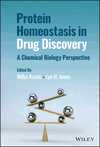CHIOSIS LAB MSKCC


A unique chemical biology approach to understand, diagnose, and treat cellular processes associated with chronic molecular stress, with the ultimate goal of developing novel therapeutic options for use in the clinic.
Phosphorylation-driven epichaperome assembly is a regulator of cellular adaptability and proliferation
What makes cancer so aggressive and adaptable? Our latest research uncovers a hidden mechanism within cells—specialized protein networks called epichaperomes. Our latest publication is available now in Nature Communications.
Introducing dysfunctional Protein-Protein Interactome (dfPPI) - A Platform for systems-level protein-protein interaction (PPI) dysfunction investigation in disease
Click the image to read a special issue of Current Opinions in Structural Biology Biophysical Methods (2024): Protein Networks in Health and Disease featuring an article by Chiosis Lab MSKCC and collaborators.
N-Glycans' Effect on Pathologic Protein Conformations in Disease
Click the image to read an adaptation from recently published paper "N-Glycosylation as a Modular of Protein Conformation and Assembly in Disease" by Chiosis Lab MSKCC and collaborators in Biomolecules MDPI.
Synthesis & Characterization of Click Chemical Probes for Single-Cell Resolution Detection of Epichaperomes in Neurodegenerative Disorders
Click the image to read the latest work by Chiosis Lab MSKCC and collaborators in Biomedicines MDPI Special Issue Novel Diagnostic and Therapeutic Strategy for Neurodegenerative Diseases.
Editor's Choice featured in Scientific American, Nature Communications, and MSKCC Research Highlights
Click the image to read "Systems-level analyses of protein-protein interaction network dysfunctions via epichaperomics identify cancer-specific mechanisms of stress adaptation."
Unraveling the Mechanism of Epichaperome Modulation by Zelavespib: Biochemical Insights on Target Occupancy and Extended Residence Time at the Site of Action
Check out our recent publication in Biomedicines MDPI and discover the secret behind prolonged drug action and therapeutic efficacy of epichaperome agents Zelavespib and Icapamespib.
Systems-level analyses of protein-protein interaction network dysfunctions via epichaperomics identify cancer-specific mechanisms of stress adaptation
Read about how an unbiased 'Epichaperomics' platform helped us to identify context-dependent mechanisms by which cancer cells enhance the fitness of mitotic protein networks.
Synthesis of 124I-labeled epichaperome probes and assessment in visualizing pathologic protein-protein interaction networks in tumor bearing mice
Check out our detailed protocol on the synthesis of epichaperome targeting clinical agents, [124I]-PU-H71 and [124I]-PU-AD and specific steps in the use of these reagents to visualize pathologic PPI networks.
Epichaperomes as a Gateway to Understanding, Diagnosing, and Treating Disease Through Rebalancing Protein–Protein Interaction Networks
This book chapter highlights several chemical probes, from epichaperome disrupters to epichaperome affinity-purification tools and epichaperome detection and quantitation probes, and the use of these probes as therapeutic strategies aimed at normalizing PPI networks, especially in cancer and neurodegenerative diseases.
How Aberrant N-Glycosylation Can Alter Protein Functionality and Ligand Binding: an Atomistic View
Our collaborator, the colombo team, integrated computational and experimental tools to unveil the role of N-glycosylation of specific residues in glucose-regulated protein 94 (GRP94) to modulates its internal dynamics and shed light on the determinants of GRP94 response to ligands.
Pharmacologically controlling protein-protein interactions through epichaperomes for therapeutic vulnerability in cancer
We used an innovative and unbiased epichaperomic platform to show how epichaperome targeting probes makes the cancer cells maxed-out their capacity to remodel PPI networks and how the cells respond in the presence of additional therapeutic stress at this state. Check out our feature on EinPressWire: https://www.einpresswire.com/article/557136874/a-cellular-traffic-jam-for-precision-medicine-in-cancer
Targeting the epichaperome as an effective precision medicine approach in a novel PML-SYK fusion acute myeloid leukemia
Check out our feature on the Weill Cornell Medicine website: https://news.weill.cornell.edu/news/2021/09/it%E2%80%99s-an-absolute-miracle-battling-a-deadly-blood-cancer-a-new-jersey-woman-gets-a





.png)



























